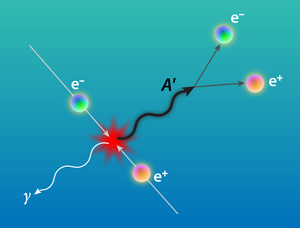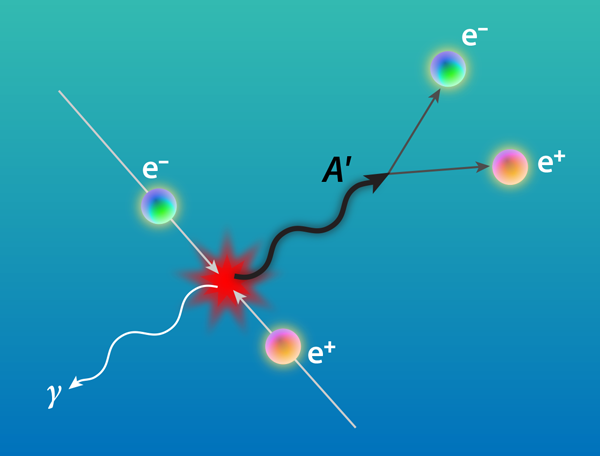New Light Shed on Dark Photons
Particle physics is in a very interesting phase where major discoveries are hotly anticipated. But predicting where or when breakthroughs will occur is highly speculative. We have the extremely successful standard model as the guiding theoretical description of fundamental particle physics, which encompasses the known basic constituents of matter and their interactions (except gravity). With the recent discovery of the Higgs boson and the inclusion of neutrino mass, the standard model is in splendid agreement with all confirmed measurements. However, it is also clear that particle physics is playing the game with much less than a full deck of “cards” because of the apparent existence of dark matter and dark energy, which, respectively, constitute 25% and 70% of the Universe’s energy budget, based on information from astrophysical and cosmological observations. The standard model only covers the remaining 5% that consists of ordinary matter.
Several attempts have been made to extend the standard model, particularly into the realm of dark matter [1]. Beyond its gravitational interactions, very little is known about dark matter except that it appears to be slow moving (or “cold”). It is speculated that within dark matter there might be a family of particles and forces—a so-called “dark sector”—that has thus far escaped detection. In analogy with electromagnetism, for which the massless photon is the force carrier between charged particles, there could be a dark electromagnetism with a possibly massive dark photon that transmits the forces between dark particles [2]. The BaBar collaboration at the SLAC National Accelerator Laboratory in California are now reporting on their search for evidence of this dark photon [3]. The researchers did not detect a dark photon signature in their electron-positron collision data, allowing them to place new stricter limits on dark sector models, including ones trying to explain a possible discrepancy between the measured and predicted value of the anomalous magnetic moment of the muon.
The dark photon search is but one of many approaches for trying to detect dark matter. At the Large Hadron Collider, high-energy reactions are being probed for signs of new massive particles and interactions. Smaller dedicated efforts, such as the SuperCDMS [4] and LUX [5] experiments, are also seeking direct evidence for the presence of dark matter through its possible interactions with ordinary matter. Other experiments study processes that are rare or forbidden in the standard model, seeking to reveal small deviations from expectations that would indirectly indicate the existence of new physics effects. So far, these experiments have allowed physicists to place limits on various hypotheses involving the masses and interaction strengths of dark matter particles.
The dark photon (which, appropriately for such a mysterious entity, has many aliases like hidden photon, heavy photon, and A′) may couple to standard model particles, such as quarks and charged leptons. In addition, it may be as light as several MeV/c2, so there could be numerous possible ways to produce and observe it—assuming it doesn’t decay principally into other invisible lighter dark particles [1]. One method involves sending a high-intensity beam of electrons or protons into a massive beam dump from which only weakly interacting particles created in the collisions are able to escape. A dark photon could be one of these emerging survivors, and it might identify itself through subsequent decay into standard model particles such as an electron and a positron ( A′→e+e- ). Even if the dark photon decay products are other dark sector particles, these could emerge from the dumps and have observable interactions in detectors [6]. Dark photons could also be produced in meson decays (e.g., π0→γA′ and φ→ηA′), in fixed-target scattering reactions ( e-+Nucleus→A′+… ) or in electron-positron colliding beam experiments (e.g., e+e-→γA′) [1]. The dark photons could be detected via their decay products, or—in certain cases—their presence could be inferred from events with missing mass.
For its part, the BaBar collaboration has looked for interactions of hypothetical dark photons with ordinary matter using electron-positron collision data [3]. BaBar extended its previous studies [7] to higher sensitivity and a wider range of masses by using a larger set of data taken at the asymmetric e+e- collider center-of-mass energy corresponding to the Υ(4S) resonance (approximately 10.6GeV) and other energies. In particular, the researchers searched for events where an electron-positron collision produced a dark photon and a normal photon, followed by the dark photon decaying into either an electron-positron pair or a muon-antimuon pair (see Fig. 1). The data analysis covered the A′ mass range between 0.2 and 10.2GeV/c2. The presence of the dark photon would be indicated by the appearance of an unexpected peak in the total mass of its decay products above smooth backgrounds. Dark photons may be expected to decay in these ways if there are no lighter dark matter particles, but the researchers discovered no evidence for peaks in the energy range studied. From this nondetection, they set new upper limits on the strength of the mixing of dark photons with standard model particles, representing improvements by about an order of magnitude over previous studies that also looked for dark photon decays into electrons/muons.
Null results like these, while not ruling out the existence of dark photons, serve as important constraints on the development of novel theories, which might extend the standard model. A case in point is the anomalous magnetic moment of the muon. Standard model predictions for the muon moment include corrections due to electromagnetic, weak, and strong interactions. If a dark photon existed, and its mass and mixing strength were within a certain range of values, then it could contribute additional corrections. Theorists have proposed that a dark photon contribution could explain a possible (but not yet confirmed) discrepancy reported between the expected and measured values for the anomalous magnetic moment of the muon [8–10]. However, the BaBar result nearly rules out the remaining parameter space for the simplest dark sector explanation. Future experiments covering a wide scope of possibilities, such as fixed target experiments planned at Jefferson Laboratory in Virginia, will extend the sensitivity and mass range of the search for dark photons [1] or possibly find evidence for them if they actually exist. Another exciting possibility is that the highly sensitive experiments searching for dark photons could discover some new phenomenon (unrelated to current speculations about dark matter particles) that lead the field in entirely new directions.
This research is published in Physical Review Letters.
References
- See R. Essig et al., “Dark Sectors and New, Light, Weakly-Coupled Particles,” arXiv:1311.0029v1 and references therein
- B. Holdom, “Two U(1)’s and ϵ Charge Shifts,” Phys. Lett. B 166, 196 (1986); N. Arkani-Hamed, D. P. Finkbeiner, T. R. Slatyer, and N. Weiner, “A Theory of Dark Matter,” Phys. Rev. D 79, 015014 (2009); M. Pospelov and A. Ritz, “Astrophysical Signatures of Secluded Dark Matter,” Phys. Lett. B 671, 391 (2009)
- J. P. Lees et al. (BaBar Collaboration), “Search for a Dark Photon in e+e− Collisions at BaBar,” Phys. Rev. Lett. 113, 201801 (2014)
- A. J. Anderson (SuperCDMS Collaboration), “ et al.Constraints on Light WIMPs from SuperCDMS,” arXiv:1405.4210
- D. S. Akerib et al. (LUX Collaboration), “First Results from the LUX Dark Matter Experiment at the Sanford Underground Research Facility,” Phys. Rev. Lett. 112, 091303 (2014)
- See, for example, B. Batell, R. Essig, and Z. Surujon, “Strong Constraints on Sub-GeV Dark Sectors from SLAC Beam Dump E137,” Phys. Rev. Lett. 113, 171802 (2014)
- B. Aubert et al. (BABAR Collaboration), “Search for Dimuon Decays of a Light Scalar Boson in Radiative Transitions Υ→γA0,” Phys. Rev. Lett. 103, 081803 (2009); J. D. Bjorken, R. Essig, P. Schuster, and N. Toro, “New Fixed-Target Experiments to Search for Dark Gauge Forces,” Phys. Rev. D 80, 075018 (2009)
- M. Pospelov, “Secluded U(1) below the Weak Scale,” Phys. Rev. D 80, 095002 (2009)
- H. Davoudias, H.-S. Lee, and W. J. Marciano, “Dark Side of Higgs Diphoton Decays and Muon g−2,” Phys. Rev. D 86, 095009 (2012)
- M. Endo, K. Hamaguchi, and G. Mishima, “Constraints on Hidden Photon Models from Electron g−2 and Hydrogen Spectroscopy,” Phys. Rev. D 86, 095029 (2012)





